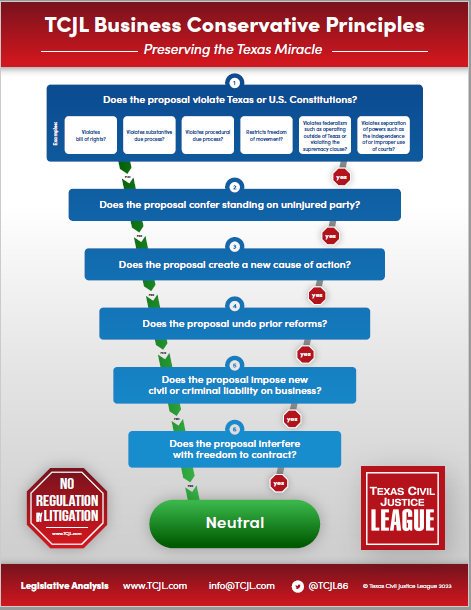 In a case in which we and just about every other organization on the defense side of the bar appeared as amici, the Texas Supreme Court has reversed a Houston [14th] Court of Appeals opinion affirming a $100 million verdict against a commercial trucking company.
In a case in which we and just about every other organization on the defense side of the bar appeared as amici, the Texas Supreme Court has reversed a Houston [14th] Court of Appeals opinion affirming a $100 million verdict against a commercial trucking company.
The facts in Werner Enterprises, Inc. and Shiraz A. Ali v. Jennifer Blake, Individually and As Next Friend for Nathan Blake, and as Heir of the Estate of Zachery Blake, Deceased; and Eldridge Moak, in his Capacity as Guardian of the Estate of Brianna Blake (No. 23-0493; June 27, 2025) are unspeakably tragic. On a wintry night in December 2014, Plaintiff and her three children were driving eastbound on I-20 near Odessa when the driver of their vehicle lost control, crossed a 42-foot grassy median, and collided with an 18-wheeler traveling over 40 miles per hour. Plaintiff’s seven-year-old son died and his 12-year-old sister suffered a traumatic brain injury that left her a quadriplegic. Plaintiff’s third child, a fourteen-year-old boy, suffered serious internal injuries. Plaintiff incurred a mild traumatic brain injury and other injuries. Plaintiff sued the trucking company (Werner) and the driver of the 18-wheeler (Ali). After a trial, the jury awarded more than $100 million in damages. The trial court entered final judgment in July 2018. Defendants appealed.
In an en banc opinion, a split Houston [14th] Court of Appeals affirmed. The 89-page majority opinion authored by Justice Hassan, in which Justices Bourliot, Zimmerer, Spain, and Poissant joined, affirmed. Chief Justice Christopher, joined by Justices Wise, Jewell, and Wilson, dissented. She found the majority at fault for failing to address Werner’s properly preserved objection to a jury charge imposing “a general negligence duty on Werner, acting through employees other than [the driver]. The question did not define what that duty was—what objective conduct such unidentified employees were required to perform, or to refrain from performing—instead leaving individual jurors to make up these standards for themselves.” Instead, the majority’s analysis of the duty question “fail[ed] to specifically identify what the exact duty was—outside of supervision and training. It also put[] the burden on Werner to rebut the duty the majority created (that no court has ever recognized).” The chief justice would have reversed and remanded for new trial because the erroneous submission of the general negligence question introduced an invalid legal theory upon which the jury could have predicated its allocation of fault to Werner. This is the Casteel problem that Werner properly preserved for appeal and that the majority brushed aside. However, she disagreed with Justice Wilson’s dissent, which, as noted below, calls for the adoption of the “Admission Rule.”
Justice Wilson, joined by Justices Wise and Jewell, filed a separate dissenting opinion. He advocated for the adoption of the “Admission Rule,” which would, with the exception of exemplary damages, “bar[] a party allegedly injured by the employee’s negligence from pursuing derivative theories of negligence against the employer” if the employer stipulates course and scope. Since Werner did that in this case and the evidence was insufficient to support a gross negligence finding, Justice Wilson would hold that the trial court erred in denying its motion for a directed verdict on the derivative theories. He would thus reverse the trial court’s judgment, enter a judgment that Plaintiffs take-nothing on their derivative claims, and remand for new trial.
In an opinion by Chief Justice Blacklock, joined by Justices Devine, Busby, Young, and Sullivan, SCOTX reversed and rendered judgment for Defendants. The central issue was whether the truck driver’s (Ali) negligence was the proximate cause of Plaintiffs’ injuries. Proximate cause requires both cause in fact and foreseeability. Cause in fact requires “but-for” causation and “substantial factor” causation, that is, “that the defendant’s conduct has such an effect in producing the harm as to lead reasonble men to regard it as a cause . . . in which there always lurks the idea of responsibility.” Put another way, the question is whether the defendant is “actually responsible for the ultimate harm” or “the defendant’s conduct ‘merely creates the condition that makes the harm possible.” The Court concluded that the “no reasonable juror could assign responsibility for these injuries to anyone other than the driver who lost control of his vehicle and hurtled across a 42-foot median into oncoming traffic, thereby causing the accident and these injuries in every leglly relevant sense of the word.”
Plaintiffs’ argument boiled down to the assertion that the truck driver, though below the speed limit, was driving too fast on an icy road and couldn’t get out of the way when a pickup truck appeared out of nowhere from the other side of a 42-foot median. They contended, and the court of appeals agreed, that the truck driver should either have been driving at 15 mph or not driving at all. But, as the Court observed, Plaintiffs didn’t say anything about the driver of the pick-up and why he lost control on the same icy road. If the truck driver was negligent in driving too fast, it merely created the condition by which the pick-up truck driver’s negligence could bring about the injury. [The Court observed that the accident could have been avoided if Ali had been driving at 100 mph instead of 50.] That the truck was in that particular spot on the highway at the precise time the pick-up truck went out of control was “just the kind of ‘happenstance of place and time’ that cannot reasonably be considered a substantial factor in causing these injuries.” The pick-up truck driver’s loss of control was the only substantial factor in causing them.
Having found that the truck driver’s negligence, if it was negligence, was not a proximate cause of the accident, the Court turned to whether the derivative negligent training and supervision judgment against Werner could survivie. The Court said no. Once again, the Court stated that “[w]e have not recognized negligent training or supervision an independent theory of tort,” although you wouldn’t know it by the way plaintiff’s lawyers do commercial trucking cases. The Court has indicated that in a negligent hiring case, an employer might be found independently negligent in hiring an employee who committed a negligent act, as long as both negligent acts proximately caused the injury. Endeavor Energy Res., L.P. v. Cuevas, 593 S.W.3d 307, 311 (Tex. 2019). This would be true of a negligent supervision and training claim as well, so even if Texas law did recognize such a claim, it failed here because Ali’s driving didn’t proximately cause the injuries. “There are no viable theories of liability alleged against Werner that are independent of Ali’s responsibility for the Blakes’ injuries,” the Court concluded. “All the claims against Werner are, in that sense, ‘derivative’ of Ali’s liability—for which Werner would bear responsibility as Ali’s employer, whether or not the Blakes alleged additional theories of Werner’s liability.”
Justice Young, joined by Justice Huddle, concurred. He points out that the Court’s decision “wipes the slate clean, and the court of appeals’ discussion of the admission rule is no longer precedent even in that court.” Justice Young went on to discuss the rationale in favor of the admission rule and observed that Texas intermediate courts of appeals (except for the 14th in Werner) “have generally taken it as a given that, at least when only ordinary negligence is alleged, respondeat superior and negligent-entrustment claims are mutually exclusive theories of recovery, so acceptance of respondeat superior with respect to the alleged negligence of the tortfeasor leaves no room for derivative-negligence claims.” He argued further “[a]dmitting evidence of the employer’s hiring, training, or supervision practices, if formally irrelevant, not only jeopardizes efficiency but also threatens the integrity of the results.” If an employer accepts responsibility, that should be the end of the inquiry. Admitting evidence “of the alleged negligence of multiple employees other than the driver risks inflating damages beyond their actual amount or distorting the attribution of liability (or both).” Though this case may not have properly presented the admission rule for the Court’s consideration, Justice Young indicated that he was “inclined to vote to adopt” it.
Justice Bland, joined by Justices Boyd and Huddle, dissented in part. While agreeing with the Court that the trial court made a mistake in rendering judgment on the jury’s verdict, she pointed to the jury charge as the source of the problem in this case. The trial court, according to Justice Bland, should not have submitted the derivative negligence theories aimed at Werner’s conduct because Werner had accepted responsibility for the driver’s actions. This charge error resulted in misleading the jury “into placing disproportionate responsibility for the Blakes’ injuries on Ali and Werner” (84% to be exact). Consequently, Justice Bland would remand for a new trial.
In our view, all three opinions are correct. Along with Justices Young and Huddle, we hope that SCOTX gets the right case to settle the admission rule issue on permanent lines. Along with Justices Bland, Boyd, and Huddle, when “reptile theory” tactics infect the presentation of a case with “formally irrelevant” evidence of an employer’s “independent” negligence, and when the jury charge is tilted in that direction, nuclear verdicts are the result. And along with Chief Justice Blacklock and Justices Busby, Devine, Young, and Sullivan, it’s really hard to see how Werner could be held responsible for causing the injuries under these facts. Not in a case in which an out-of-control vehicle crosses a 42-foot grass median into oncoming traffic as fast as this one did. In any event, it’s a tough decision to make all the way around, and we applaud the Court for the deliberate and compassionate way that it approached it.












